by Winding Pathways | Aug 24, 2017 | Wonderment
Winding Pathways asked for reader submissions on what they love about summer and here is what folks shared.
Dan P was the first. with this short, pithy remark: “Summer = it’s not cold ;)”
And here is the back story on that. As a kid and teen until his Junior year in high school, Dan delivered first the Penny Saver and then the Cedar Rapids Gazette. Every day all year round. Only a few times, when we did our annual Black Hills vacation, did he get a substitute. So, he was up before dawn, bagged and banded papers and walked his route. Then, he’d come back and go to bed, or head off to early bird classes at Washington H.S. On really bitter winter days Rich went with him to get the route done safely and more quickly. He has always been a hard and reliable worker with the mantra: “Show up. Work hard. Be honest. Be nice.”
Here is a picture in winter 1994. And a recent photo. So now you know what Dan loves about summer.
-

-
January 1994
-

-
Summer
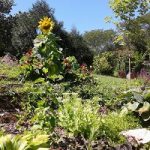
Giant Sunflower
Jan Watkins added this amazing picture of the “Daddy Sunflower” in her yard and how it came to be. “I have never raised sunflowers, so last year when a sunflower appeared in this location, I was delighted. It seemed so special there on the ledge. Not really looking into the sun, but rather it seemed, it was looking in at me. It was fun to see the goldfinches feasting on the seeds. This year, I’ve watched the sunflower grow and bloom in the same place as last (year), again facing into my house. It makes me think of Roy. He lived in Kansas for years, the Sunflower State. Its leaves have ruffled edges, a big flower on a short, strong stalk, different from the others. Definitely special. I have to smile. I love it.”
From Joye Winey: “The best part of summer is Saturday Morning Market. From early summer with jackets and jeans to midsummer with short and flip flops. From greens, rhubarb, peas, to melons, zucchini, tomatoes, corn eggplants and sunflowers— A great way to start the day. :)”
-

-
“I’d Rather be at the Farmers’ Market”
-

-
Fresh herbs
-

-
Jugglers and musicians entertain.
From Rebecca Groff: “A Peaceful Iowa Morning”
“The lack of any human noise outside my bedroom window greeted me on an early August morning, and the Universe’s message was clear: preserve this special moment. So I grabbed my camera to capture the sights and sounds on our acreage, which happens to be my favorite kind of church.
“Outside, sparrows and mourning doves took breakfast at the bird feeder in among a stand of white pines as I strolled around the yard videoing this peaceful Iowa morning. A capiz shell wind chime jingled softly in the background.
“It was too early for butterfly activity, but just right for the small rabbit that darted out from the butterfly garden, having finished off most of the young delphinium I’d planted in my butterfly garden this past spring. Ah, well. There is a bit left and maybe it will come back. I know bunnies need to eat, too. (Sigh . . . . ) At one time I’d considered seeding that spot over to make it easier to mow, but then the idea came to plant it solely for the butterflies and other pollinators, and I’m glad I went with that decision. Pink and purple phlox, native purple coneflowers, various lilies, Japanese iris, gaillardia, coreopsis and bee balm in red and pink have been well received so far this summer.
“Were someone to offer me a tranquilizing pill, or a chance to be outside working in my yard, hands and nails filthy with soil, the dirt work would win every time. “Dirt therapy,” my sister and I call it. We both agree it can soothe the roughest emotion days.
“In front of our house I established a circular butterfly garden. This year I filled it with pink and white cosmos, coreopsis, nasturtiums, and zinnias to keep company with the two tomato plants I set out — one red and one yellow. Just enough for us and for sharing with our neighbors.
“The acidic smell of tomato plant green is one I never tire of and I couldn’t resist rubbing the tender leaves between my fingers. There was a B-L-T sandwich coming my way in the near future!
“The sun was edging higher in the sky, and the sound of traffic on the main road a mile away was starting to pick up. Soon there would be lawn mowers whirring, and kids bursting outdoors to play and the weekend busyness of humanity all about the neighborhood.
“But for a few minutes, I had the best spot in the Universe all to myself, surrounded only by trees, flowers, birdsong and fresh dew on the tips of my toes.”
-

-

-
Bursting with color
Susan F in Arizona wrote: “Weather is easing back from triple digit temperatures to upper nineties. And we have had a bit of humidity the past week or so. Of course our humidity is nothing like what happens out east. Humidity was in the 50’s this week. The monsoon rains have been causing quite a bit of flooding but it has been spotty. All depends on the terrain what kind you get, flash floods in the hill country or just high water on flat land. Canals and runoff ditches help in the larger cities, but there is no decent drainage system to keep streets (from) flooding.
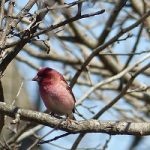
Finches fun to watch.
“I still enjoy my birds. I continue to get sparrows, finches, hummingbirds and Quail families. I have watched the baby quail grow from tiny babies (no bigger than a silver dollar) to toddlers, preteens, to teenagers. Right now the oldest of this year’s babies have color patterns which have helped ID them by sex. I know I have three male teenagers. The next batch coming along is almost to that stage and the littler ones are developing the topknots on their heads. Sometimes I have all three age groups, other times only the oldest three come alone with no parents to escort. The younger ones come with their parents still. Fun to watch. I also have a curve-billed thrasher that spends more and more time each day by the food block. It especially likes mornings and late afternoon.”
Jackie and Peter Hull in Virginia take in the back roads with these observations: “On a pristine day with not a cloud in the skies we often begin a journey northwest to the Blue Ridge Parkway. It is here that we can see for miles to the north, south, east and west. Looking westward over the Great Valley we can view the Allegheny Mountains stretching clear to West Virginia. We marvel that the pioneers were able to cross the Blue Ridge and Allegheny mountains on foot, horseback and rafts down the multiple rivers and streams to settle the country centuries ago. Enjoy our country and love it!”
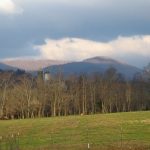
Clouds over mountains
And another observation from Virginia: “Tuesday we had some intense storms here in Bedford,
Virginia. As I looked out the French door windows, I could see some nasty clouds slowly slipping over the mountains. For a while nothing happened. I turned away to fold some clothes. As I moved back into the living room, I was startled to see a grey white cloud had completely enshrouded the
western mountains. At first I was perplexed. Then I whispered, “Oh, my gosh.” I could hear the rain pounding as this cloud steadily moved closer to us.
“The trees disappeared as did the silo and then the house next door became a blur. All at once the rain was pounding on the roof and I could hardly see my vegetable garden. Passing slowly over my house the rain continued eastward obstructing the eastern view of Turkey Mountain. After all was said and done, we had two inches of rain in a short time frame.”
by Winding Pathways | Jul 4, 2017 | Labyrinths, Wonderment
Labyrinths come in many shapes and sizes. This spring and summer we’ve been busy re-designing and re-naming the 1080 Labyrinth. Now the Phoenix Harmony Labyrinth, it is five circuits and is honored in its center with a Bur Oak. Phoenix because we burn the labyrinth every year to promote the prairie plants and Phoenix because from the ashes we re-designed a dual entry Harmony labyrinth in the Lisa Gidlow Moriarty tradition.
Also, I’ve hosted walks with the most recent being in Duluth, MN, at the Outdoor Writers Association of America annual conference.
Enjoy the photo albums and reflections.
by Winding Pathways | May 9, 2017 | Flowers/Grasses, Nature, Trees/Shrubs, Wonderment
We invited readers of Winding Pathways blogs to submit a photo and short description of a favorite spring scene. The response spanned from the Pacific Northwest to Canada and from the Desert Southwest to New England. Enjoy readers’ reflections on our emerging spring. The essays appear as they came in to Winding Pathways. Thank you all for your charming observations. Happy Spring! And soon, welcome summer.
***
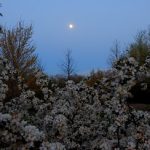
“Every year I wait for our Sargentina crab apple trees to bloom.”
As much as I love our native prairie plants and various garden inhabitants, every year I wait for our Sargentina crab apple trees to bloom. Not too long ago, in the company of one of our barn cats, I sat out on the patio and watched the full moon rise with the sweet smell of the flowers drifting over. Bees lay full claim to the blossoms during the day, from the little sweat bees to the bumbles, so I try to give them some space and wait until evening before diving nose-first into the branches myself.
Emily Groom Hemmerling, Kansas
***
Here in NH, spring is slowly unfolding. The barred owls are getting amorous and I’ve heard, although not seen, “our” hawks. There’s a barn swallow that’s building a nest under the eaves, and the bear visited the other night. The weather seems to be lacking any nuance. We are alternating between two or three days of cold, windy, rainy (tell the truth–nasty) days and occasional beautiful sunny days in the ’70s.
Waiting is hard after a long winter, but change should accelerate very soon. The hummingbirds return on average on May 11th, and by then many flowers should be in bloom and the trees that are barely budding today will be fully green. This time of year Carly Simon is often on my mind–“Anticipation”. Sue Fehsinger, New Hampshire
-
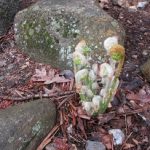
-
Unwinding slowly, fiddle head ferns appear mysteriously.
-
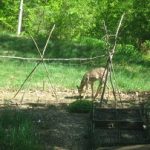
-
Deer In Garden
-
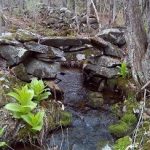
-
A New Hampshire springtime brook graced with Skunk Cabbage.
-
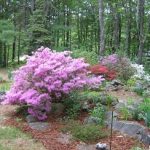
-
A splash of color!
***
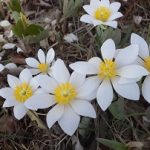
Dazzling white petal surround deep yellow centers.
These Bloodroots are found at the western end of our road. We have now lived on this road for 17 years and have watched the progression of growth and expansion each year of more and more desirable plants. The area has become a huge carpet of white under all the trees. The blossoms on the north side of the road show their faces first and a few days later the blossoms on the south side of the road appear. Since we have been here, each year it has been the same blooming schedule. We also have Bloodroots in our yard which don’t appear until the ones on the road seem to be in full bloom. They are only 1/4 mile apart.
I photographed this forsythia at the edge of our neighbor’s property. I do not have any on our property. It was a beautiful sunny day and the yellow of the blossoms was brilliant. I was also trying to get a different angle on the blossoms, rather than the whole bush.
My purple hyacinths are still producing blooms in my small north facing garden. This year they seemed to have a deeper purple color and more blossoms on the stock.
The Virginia bluebells are now blossoming. I counted 16 clumps of them in a small area at the top of our dry kettle. I am even finding small self-seeded plants.
We are privileged to see wood ducks in our channel in the early spring. They are very skittish and it is difficult to sneak up on them to get a photo. We see them for a short time and then they disappear until next year. Sue Hrobar, Wisconsin
-
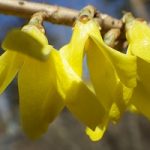
-
Like gold the flowers shine.
-
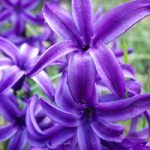
-
Beautiful Purple Blossoms
-
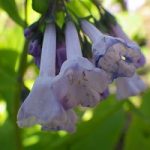
-
Close-up view
-

-
Searching for the right home.
***
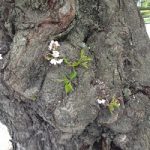
The ancient tree sprouted leaves and flowers all over.
I walked this Chestnut Hill neighborhood in Boston often while living and working in the area. My first fall a few heavily gnarled trunks of a handful of trees planted in the boulevard strips particularly captivated me. These trunks reminded me of Italian grandmothers; stout, sturdy, not particularly tall, deeply wrinkled and absolutely beautiful. When spring arrived I was amazed to see how blossoms not only appeared in their canopies but also sprang from their very bark. I loved these elderly trees all the more and saw them as clothed from head to toe in spring attire. May all of us exhibit such beauty and grace as we mature. Adria J, Illinois and Maine
***
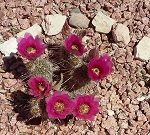
The desert Southwest alive with color.
Here is my first cactus bloom of the season! Soon my yard will be bursting with color, from all of the different cacti!
Coming from the Midwest, this is such a different sort of pretty. Most of the year it is dry and barren up here in the high desert. These little bursts of color that pop up in the spring are such a delight! I love to walk in my neighborhood and see all of the different blooms. We have a very mild winter and sometimes it’s hard to tell that spring is here, at least for this Midwestern gal. The flowers alert me that spring has indeed arrived! Such a contrast to these prickly little fellows. Add to that the brilliant green of the trees, looking almost iridescent, and the scent of the roses that pop up everywhere, I would say that spring is my
favorite season here. Deb Karpek, Arizona
***
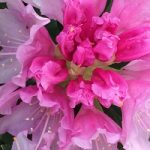
A close up of a western Rhododendron.
After the daffodils and the flowering trees fade is time in the Pacific Northwest for our native rhododendron to flower. They grow wild on the coast, but also are prized in yards because their large leaves are green all winter. Found growing wild near Port Discovery on the Washington coast in 1792 by Archibald Menzies who was with George Vancouver, it has been a favorite ever since. Officially it has been the Washington state flower since 1995, but women in 1893 designated it as such for a Worlds Fair that year. The rhododendron pictured is the Washington Centennial rhododendron from 1989. I love the way the blooms start out bright pink and fade to a pale pink as they open.
Jocelyn Berriochoa, Washington state
***
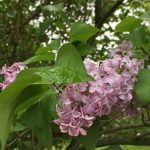
Raindrops on lilacs.
I opened the door this morning and looked out to see our lilacs blooming; pretty as could be. I thought, “Thank you, Grandma, for planting them over seventy plus years ago.” What a special way to start the day and welcome some of the beauty of spring. Claire Patterson, New Jersey
***
Spring came early to Bedford, Virginia, this year by about three weeks which means farmers, orchardists and gardeners began planting and hoping for early crops. Then to their surprise, we had two serious freezes back-to-back in March. The orchardists were especially chagrined because peaches, pears and apples took a hit. Watch for rising fruit prices.
As a gardener, it was thrilling to clean out the flowers and raised vegetable beds early on. As I began checking the asparagus patch, I noticed two silvery milkweed spears poking their heads through the soil next to the asparagus. They had begun their quiet vigil for the returning Monarch butterflies. I know the Monarchs have reached their most northern breeding grounds. However, I’ve not seen one returning Monarch here at the Ridge House.
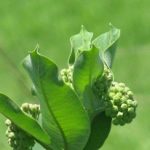
Milkweed is an important plant for Monarchs and other pollinators.
How did the milkweed come to be in my asparagus bed? There are a number of possibilities. Perhaps the birds deposited the seeds long ago. Or, the wind may have blown these wispy silky pinwheels into the patch. Another thought occurred to me that the seeds may have been tangled in the straw I scattered in the patch to help hold moisture through the dry summer months. However the seeds arrived, they are a God send as unthinking highway department mowers clear the roadsides, or a farmer applies toxic weed killer, or a home owner wanting a pristine lawn shears them off. The end result is far fewer pollinators like Monarchs and other butterflies, bees, and even birds. Where am I going with this you ask? This sage says, “All my weeds are wildflowers.” Peace. Jackie Hull, Virginia
***
-
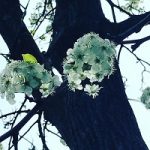
-
Spring in NYC
-

-
New York City is awash with soft color in the spring.
Spring in New York City. Dan Patterson, New York
***
Snow is melting gradually this spring. And, despite the string of rainy days lately, at the end of April we still had mounds of it around the house and in the woods.
The slow melt has meant that I’ve kept up with yard cleanup and, while trimming around the edge of the yard, I have come across early gems, like the bright purple crocuses with their eye-popping yellow-orange stamen, nestled among moss covered rocks near the path into the woods.
Elsewhere, along the edge of the woods, the early Spring ground cover, known as ‘William & Mary’, is starting to show its pink and blue blossoms. (I think of my patch as ‘Will & Kate’.)
And, I uncovered the little pile of beach stones that granddaughter Cadence assembled one summer.
Every Spring is different and every day brings different discoveries and possibilities in the garden.
Now, I’m headed out and about to see what new stuff is uncovered before the heavy rains come. I’m thankful we live outside the flood zone, but Fredericton will see another 100 year flood this weekend I fear. Lucy Fellows, New Brunswick, Canada
-
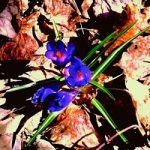
-
Poking through the leaves is a burst of color.
-
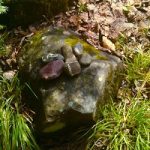
-
A stack of pebbles.
-
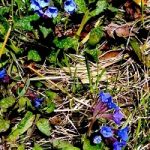
-
Early spring arrival
by Winding Pathways | Apr 22, 2017 | Birds, Flowers/Grasses, Nature, Trees/Shrubs, Wonderment
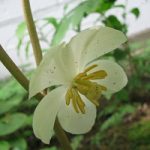
Beautiful blossoms hide under the umbrella-like leaves.
First submission in! Hey all, on Facebook Winding Pathways invited folks to submit a favorite spring photo – tree, scene, flower, animal – with a short write-up of why you like that picture. And, Kansas readers Emily and Zach Hemmerling have already replied! Way to Go!
Now, I’d love to have about a dozen more so send them in to our email and I’ll continue processing and then post. These samples of spring pictures. Join in the fun and share your descriptions!
-

-
Photo – Protective custody
-

-
Photo of sheep in pasture
-

-
Kids develop strength, cooperation, and curiosity as they explore outside.
-
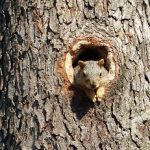
-
It’s a long way down, Mom.
-
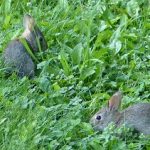
-
Bunnies are on their own as soon as the mother weens them.
-
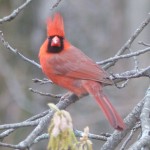
-
Photo – On a wild and windy day this Cardinal sang out his love song.
-
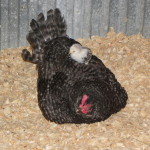
-
This mama hen with chick on her back fluffs up clean wood chips.
-
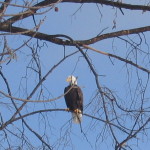
-
Eagle watching over nest.
-
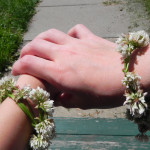
-
Clover bracelets
by Winding Pathways | Aug 20, 2016 | Bugs, Flowers/Grasses, Nature
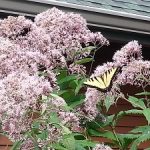
Joe-Pye Weed can grow to great heights and is a favorite of butterflies and other pollinators.
Carol Lampe shared these pictures and write up of her wondrous yard and the pollinator action on Joe-Pye Weed (Eupatorium purpureum). This is a particularly valuable fast food stop for migrating butterflies as it lasts into autumn. We have found it a bit difficult to start and then it takes off! Give it plenty of space and enjoy the butterflies.
“Here is a butterfly twofer from my flower bed. In the forefront you can see the female Eastern Tiger Swallowtail (Papilio glaucus) sitting on a Joe-Pye Weed. There were several Swallowtails out there that day.
“Joe-Pye Weed is an herb and the butterflies really seem to like it. Native Americans, and later, white settlers, made much use of Joe-Pye Weed. Teas of the roots or tops were used as a diuretic, as well as for rheumatism, gout, fevers, diarrhea, respiratory disorders, and even impotence. Modern science has not confirmed their efficacy.
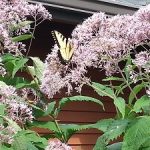
Sipping nectar on Joe-Pye Weed.
“Tucked toward the back is a Red Admiral (Vanessa atalanta). The males are territorial and many times can be found in the same location day to day.”
Thanks, Carol, for sharing your wondrous yard with Winding Pathways.










































